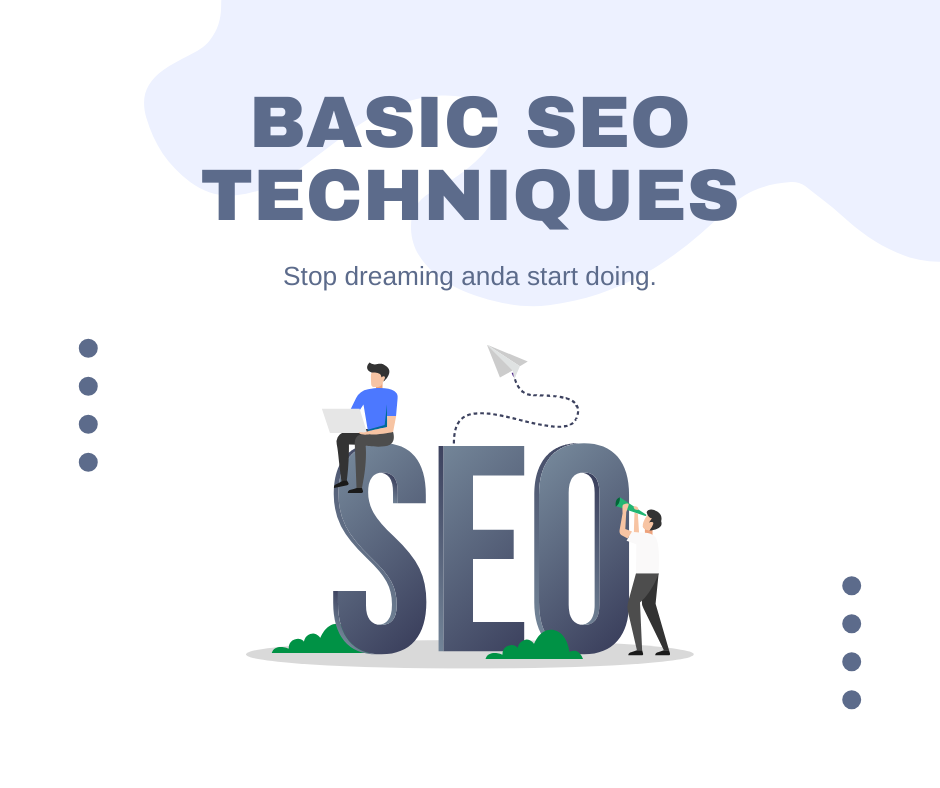Table of Contents
ToggleTable of Contents
Introduction to SEO for Beginners
Search engine optimization (SEO) is a crucial aspect of digital marketing that focuses on enhancing text to appear clear and error-free. If you want me to rewrite it, please provide the original text so I can work on it. In simpler terms, SEO aims to improve a site’s ranking on search engines like Bing, Google, and Yahoo, thereby increasing organic (non-paid) traffic to the site.
Understanding SEO
SEO refers to various strategies and techniques to optimize different aspects of a website to make it more attractive to search engines. These strategies include:
- Keyword Research involves identifying the terms and phrases users type into search engines when looking for information about your business or industry.
- On-Page Optimization: Optimizing refers to elements on your website, including titles, headings, meta descriptions, and content, to make them more relevant to target keywords and improve their visibility to search engines.
- Off-Page Optimization: Building external links from other reputable websites to yours (backlinking) to increase your site’s authority and credibility in the eyes of search engines.
- Technical SEO involves optimizing technical aspects of your website, such as website speed, mobile-friendliness, and site structure. It is important to take the necessary steps to ensure that search engines can crawl and index your website efficiently.
- Content Creation: Producing high-quality, relevant, and engaging content that provides value to your target audience, which can help attract more organic traffic and improve your site’s visibility on search engines.

Importance of SEO in Digital Marketing
SEO plays a vital role in digital marketing for several reasons:
- Increased Visibility: By optimizing your website for relevant keywords, you can improve its visibility on search engines, making it easier for potential customers to find your business online.
- Higher Traffic: Improving your site’s ranking on SERPs can increase organic traffic, as more users are likely to click on links that appear higher in search results.
- Cost-Effectiveness: Compared to paid advertising, such as pay-per-click (PPC) campaigns, SEO can be a cost-effective way to attract organic traffic to your website over the long term.
- Better User Experience: SEO involves optimizing various aspects of your website, such as site speed and mobile-friendliness, which can enhance the overall user experience and encourage visitors to spend more time on your site.
- Competitive Advantage: In today’s digital landscape, competition is fierce, having a strong SEO strategy can give your business a competitive edge by helping you stand out from competitors in search engine rankings.
SEO Tips for Beginners
- The Foundation of SEO Strategy:
- Understand your target audience and their search behavior.
- Set clear goals and objectives for your SEO efforts.
- Conduct a thorough website audit to identify areas for improvement.
- Keyword Research: The First Step:
- Use tools like Google Keyword Planner, SEMrush, or Moz Keyword Explorer to find relevant keywords.
- Focus on long-tail keywords specific to your niche and have lower competition.
- Consider user intent when selecting keywords to target.
- On-Page SEO Essentials:
- Optimize title tags, meta descriptions, and headings with relevant keywords.
- Create unique and compelling content that provides value to your audience.
- Ensure proper use of internal linking to connect related pages on your website.
- Off-Page SEO Techniques:
- Build high-quality backlinks from reputable websites in your industry.
- Utilize social media platforms to promote your content and attract natural links.
- Participate in online communities and forums relevant to your niche to establish authority and credibility.
Technical SEO Overview:
- Improve website speed by optimizing images, minifying CSS and JavaScript, and using caching plugins.
- Ensure your website is mobile-friendly and responsive for seamless user experience across devices.
- Fix crawl errors, broken links, and duplicate content to enhance search engine accessibility.
Content is King: Creating Valuable Content:
- Produce high-quality, relevant, and engaging content that addresses the needs and interests of your target audience.
- Incorporate targeted keywords naturally within your content.
- Use multimedia elements like images, videos, and infographics to enhance the user experience.
User Experience and SEO:
- Prioritize user experience by optimizing website navigation, layout, and readability.
- Improve page load times and reduce bounce rates to enhance user satisfaction.
- Implement clear calls-to-action (CTAs) to guide visitors through the conversion funnel.
- Mobile Optimization for Better Ranking:
- Ensure your website is optimized for mobile devices to accommodate increasing mobile users.
- Use responsive design to provide a consistent experience across different screen sizes.
- Test your website on various mobile devices and optimize for speed and usability.
- The Role of Social Media in SEO:
- Use social media platforms to promote your content and engage with your audience.
- Encourage social sharing to increase visibility and attract natural backlinks.
- Monitor social media mentions and respond promptly to customer inquiries and feedback.
- Local SEO: Targeting Local Searches:
- Claim and optimize your Google My Business listing for local searches.
- Include local keywords, meta tags, and business citations in your website content.
- Encourage positive reviews and ratings from satisfied customers to improve local search rankings.
By implementing these SEO tips and strategies, beginners can lay a solid foundation for improving their website’s visibility, attracting more organic traffic and achieving their digital marketing goals.
Keyword Research: Unlocking Your Potential
Keyword research is the foundation of any successful SEO or content marketing strategy. It’s identifying the terms and phrases people use to search for information online. By understanding what keywords your target audience uses, you can create content that is more likely to be found by search engines and attract qualified visitors to your website.
Tools and Techniques for Effective Keyword Research
There are several different tools and techniques that you can use to conduct keyword research. Some of the most popular tools include:
- Google Keyword Planner: This free tool from Google allows you to see how often specific keywords are searched for and the competition for those keywords.
- SEMrush: SEMrush is a paid keyword research tool that offers a wider range of features than Google Keyword Planner, including keyword difficulty scores and competitor analysis.
- Ahrefs: Ahrefs is another paid keyword research tool that provides features similar to SEMrush’s.
- Keywordtool.io: Keywordtool.io is a free keyword research tool that suggests long-tail keywords based on Google Autocomplete.
In addition to using keyword research tools, there are several other techniques that you can use to identify relevant keywords. These include:
- Brainstorming: Start by brainstorming keywords relevant to your business or niche.
- Competitor analysis: Look at the keywords your competitors are ranking for.
- Content analysis: Analyze your existing content to see which keywords you already rank for.
- Social media listening: Use social media listening tools to see what people are talking about on social media.
Understanding Keyword Intent
Keyword intent is the reason why someone is searching for a particular keyword. There are four main types of keyword intent:
- Informational: Informational keywords are used by people looking for information on a particular topic. For example, someone searching for “best keyword research tools” is likely in the informational stage of the buyer’s journey.
- Navigational: Navigational keywords are used by people looking for a specific website or web page. For example, someone searching for “Wikipedia” is likely using a navigational keyword.
- Transactional: Transactional keywords are used by people who are ready to make a purchase. For example, someone who is searching for “buy running shoes” is likely using a transactional keyword.
- Commercial: Commercial keywords are used by people who are interested in learning more about a product or service before making a purchase. For example, someone who is searching for “reviews of the best running shoes” is likely using a commercial keyword.
By understanding keyword intent, you can create content that is more likely to meet the needs of your target audience.
Long-Tail Keywords vs. Short-Tail Keywords
Short-tail keywords are keywords that are only a few words long, such as “running shoes”. Short-tail keywords are generally more competitive than long-tail keywords.
Long-tail keywords are keywords that are more specific, such as “best running shoes for women with wide feet.” Long-tail keywords are generally less competitive than short-tail keywords and can be a great way to target a more specific audience.
Competitor Keyword Analysis
Competitor keyword analysis is the process of identifying the keywords for which your competitors are ranking. By understanding your competitors’ keywords, you can identify opportunities to target new keywords that you may not have considered before. You can also use competitor keyword analysis to see how your website stacks up against your competitors in terms of SEO.
On-Page SEO: Optimizing for Search Engine Success
Once you’ve unlocked your keyword potential through research, it’s time to optimize your website for those keywords. This is where on-page SEO comes in. On-page SEO involves optimizing the elements on your actual web pages to improve your ranking in search results. Here are some key areas to focus on:
Title Tags and Meta Descriptions:
- Title Tags: These are the clickable headlines that appear in search results. They should be concise (around 60 characters) and include your target keyword naturally.
- Meta Descriptions: These are short summaries (around 160 characters) that appear below the title tag in search results. They should be compelling and informative, encouraging users to click on your page.
Header Tags and SEO Structure:
- Header Tags (H1, H2, H3): Structure your content using header tags to break up your text and create a clear hierarchy. Include your target keyword naturally in your H1 tag (main heading). H2 and H3 tags can target related keywords and subtopics.
- SEO Structure: Organize your content logically with a clear introduction, body, and conclusion. Use bullet points, numbered lists, and images to improve readability.
Internal Linking Strategies:
- Internal Links: Link to relevant pages on your website within your content. This helps search engines understand the structure of your site and improves user navigation. Use relevant anchor text (the clickable text) that includes your target keywords.
Image Optimization and Alt Text:
- Image Optimization: Large images can slow down your website’s loading speed, which can hurt your SEO. Resize images before uploading, and consider using image compression tools.
- Alt Text: Add alt text to your images, describing the content of the image. This helps search engines understand your images and improves accessibility for visually impaired users. You can also include your target keywords here, but prioritize accurate descriptions.
By focusing on these on-page SEO elements and incorporating your keyword research, you can create content that is not only informative and engaging for your target audience but also optimized for search engines to rank higher and attract more organic traffic.
Off-Page SEO: Building Authority and Trust
While on-page SEO optimizes your website itself, off-page SEO focuses on building your website’s reputation and authority in the eyes of search engines. This is primarily achieved through link-building and increasing brand awareness.
Link Building Strategies:
Link building is the process of acquiring links from other websites to your own. Search engines view backlinks as a sign of trust and credibility. The more high-quality backlinks you have, the higher your website will likely rank in search results. Here are some strategies to consider:
- Create high-quality, shareable content: This is the foundation of any link-building strategy. If you create content that is informative, engaging, and valuable to your target audience, people will naturally want to link to it.
- Guest blogging: Write guest posts for other websites in your niche. This is a great way to get your content in front of a new audience and earn backlinks to your website.
- Broken link building: Find websites with broken links on pages relevant to your niche. Then, create content that is a better fit for the broken link and reach out to the website owner to suggest your content as a replacement.
Guest Blogging and Backlinks:
Guest blogging is a win-win strategy. You contribute valuable content to another website, expanding your reach and potentially earning a backlink. But remember, quality matters. Focus on guest blogging for sites with good reputations and relevant audiences.
The Importance of Social Signals:
Social media engagement is another important factor in off-page SEO. When people share your content on social media, it sends a signal to search engines that your content is valuable and relevant. Additionally, having a strong social media presence can help you build brand awareness and drive more traffic to your website.
While link building is a crucial part of off-page SEO, it’s important to focus on acquiring high-quality, natural links. Avoid link-buying schemes or other manipulative tactics, as these can actually hurt your SEO in the long run.
By implementing a well-rounded off-page SEO strategy that combines link-building, social media engagement, and brand-building activities, you can establish your website as a trusted authority in your niche and improve your search engine rankings.
Technical SEO: Behind the Scenes Optimization
Technical SEO involves optimizing the technical aspects of your website to make it search engine-friendly. This foundation ensures search engines can easily find, understand, and index your content, ultimately improving your search visibility. Here’s a breakdown of key technical SEO areas:
Website Speed and Performance:
- Search engines prioritize websites that load quickly. A slow website can negatively impact your rankings and user experience. There are many tools and techniques to improve website speed, such as optimizing image sizes, minimizing HTTP requests, and enabling browser caching.
Secure Sockets Layer (SSL) Certification:
- An SSL certificate encrypts communication between your website and visitors, protecting sensitive information. Google Chrome and other browsers now prioritize websites with SSL certificates (indicated by HTTPS in the URL).
Responsive Design and Mobile Usability:
- More and more people are searching the web from mobile devices. A responsive website design ensures your website adapts to different screen sizes and provides an optimal user experience for all devices.
Site Structure and Crawlability:
- Search engines rely on crawlers to discover and index your website’s content. A well-structured website with a clear hierarchy and internal linking strategy makes it easier for crawlers to navigate and understand your site. This includes factors like having a clean and logical URL structure, a robots.txt file, and a sitemap to guide crawlers.
By focusing on these technical SEO aspects, you create a solid foundation for search engines to effectively find and index your web pages. This, in turn, improves your website’s visibility in search results and allows you to leverage the power of on-page and off-page SEO strategies more effectively.
Content Creation: The Heart of SEO
Now that you’ve explored the technical and strategic aspects of SEO let’s delve into the heart of it all – content creation. SEO-friendly content is the fuel that drives your website’s ranking and attracts organic traffic.
Writing SEO-Friendly Content:
- Keyword Integration: While keyword stuffing is no longer a viable strategy, strategically incorporating your target keywords throughout your content (title, headings, body text) helps search engines understand your content’s relevance.
- Informative and Valuable: Focus on creating high-quality content that provides genuine value to your target audience. Address their needs, answer their questions, and solve their problems.
- Readability and Clarity: Structure your content logically with clear headings, subheadings, and bullet points for easy navigation. Write in a clear and concise style that is easy for your audience to understand.
The Power of Multimedia:
- Images and Videos: Break up text with relevant images, infographics, and videos. These elements can enhance user engagement, improve comprehension, and make your content more visually appealing.
- Optimize Multimedia: Ensure all multimedia elements (like images) have descriptive alt text that incorporates relevant keywords for both SEO and accessibility purposes.
Engaging and Retaining Your Audience:
- Storytelling: Weave captivating narratives into your content to keep readers engaged. People connect with stories, so use them to illustrate your points and make your content memorable.
- Calls to Action (CTAs): Tell your audience what you want them to do next. Whether it’s subscribing to your newsletter, visiting a specific page, or making a purchase, clear CTAs guide users toward the desired action.
- Content Freshness: Regularly update your website with fresh content to keep visitors coming back and signal to search engines that your site is active and relevant.
Remember, SEO is a marathon, not a sprint. By consistently creating high-quality, engaging content that caters to both search engine algorithms and your target audience, you’ll establish your website as a valuable resource and achieve long-term SEO success.
User Experience (UX) and SEO: A Powerful Partnership
You’ve come a long way in understanding SEO! Here’s how UX (user experience) plays a crucial role in your SEO strategy:
The Connection Between UX and SEO:
Happy users and a positive user experience (UX) go hand-in-hand with good SEO. Search engines like Google prioritize websites that offer a smooth and enjoyable experience for visitors. Here’s how UX factors into SEO:
- Improved Site Navigation: A well-organized website with clear navigation makes it easy for users to find the information they need. This reduces bounce rates (users leaving immediately) and keeps visitors engaged on your site, sending positive signals to search engines.
- Enhancing Website Loading Speed: No one likes a slow website. Fast loading times improve user experience and are a ranking factor for search engines.
Mobile Optimization: A Necessity
- Mobile-First Indexing: Google now prioritizes mobile-friendly websites in search results. A responsive design that adapts seamlessly to all devices (desktop, tablet, mobile) is essential for SEO success.
- Optimizing for Mobile Users: When optimizing for mobile users, consider factors like mobile-friendly font sizes, finger-friendly buttons, and fast mobile page load speeds.
Social Media and SEO: An Integrated Approach
- Leveraging Social Media for SEO: Social media shares and engagement act as positive signals to search engines, indicating valuable and relevant content.
- Social Media Profiles and SEO: Optimize your social media profiles with relevant keywords and links back to your website to improve discoverability.
Local SEO: Capturing Local Audiences
- Optimizing for Google My Business: Claim and optimize your Google My Business listing to improve local search ranking and visibility.
- Local Citations and Reviews: Encourage positive reviews and mentions of your business name and address across local directories and websites. This builds trust and local SEO authority.
Monitoring and Adapting Your SEO Strategy
- Tools for Tracking SEO Performance: Utilize SEO tracking tools to monitor your website’s traffic, keyword rankings, and backlinks. This data helps you identify areas for improvement and adapt your strategy accordingly.
- Adapting to SEO Changes and Algorithm Updates: Search engine algorithms are constantly evolving. Stay updated on industry trends and algorithm changes to ensure your SEO strategy remains effective.
Common SEO Mistakes to Avoid
- Overlooking User Intent: Focus on creating content that addresses your target audience’s search intent. Don’t just stuff keywords for the sake of it.
- Ignoring Mobile Optimization: In today’s mobile-first world, neglecting mobile optimization is a critical SEO mistake.
- Neglecting Website Speed: Slow loading times can significantly hurt your SEO and user experience.
Advanced SEO Tips and Tricks
- Structured Data and Schema Markup: Implement schema markup to provide search engines with richer information about your content, potentially improving search result snippets.
- The Future of Voice Search: Voice search is becoming increasingly popular. Optimize your content with natural language queries in mind to improve voice search ranking.
AI and SEO
- AI and SEO: Artificial intelligence (AI) is playing a growing role in SEO. Tools powered by AI can help with tasks like keyword research, content optimization, and competitor analysis.
SEO Trends to Watch
- Emerging SEO Technologies: Stay informed about emerging SEO technologies like video SEO and answer engine optimization (AEO) to stay ahead of the curve.
The Evolving Landscape of SEO
SEO is a dynamic field that constantly evolves. By understanding the fundamental principles, staying updated on trends, and prioritizing both user experience and search engine optimization, you can ensure your website thrives in the ever-changing world of SEO.
Frequently Asked Questions (FAQs)
This section can address any lingering questions users might have after going through your SEO guide. Here are some common SEO FAQs you can consider:
- How long does it take to see results from SEO? SEO is a long-term strategy, and results can vary depending on your website, niche, and competition. However, with consistent effort, you can typically start to see improvements in traffic and rankings within a few months to a year.
- Do I need to hire an SEO expert? While SEO expertise can be valuable, it’s not always necessary. For beginners, there’s a lot you can learn and implement yourself. As your SEO needs grow more complex, you can consider consulting an SEO professional.
- Is SEO expensive? SEO can be a cost-effective way to improve your website’s ranking on search engines. If you are willing to invest time and effort in learning and implementing SEO best practices yourself, it can be even more affordable. There are also many free and affordable SEO tools available that can help you improve your website’s SEO. However, if you prefer to outsource SEO services to professionals, the cost can vary depending on the agency and the scope of work required.
Conclusion: Your SEO Journey Begins Now
Congratulations on taking the first step toward SEO mastery! You’ve gained a solid understanding of the core principles and various aspects that influence a website’s search engine ranking and organic traffic. Remember, SEO is an ongoing process. Stay curious, keep learning, and adapt your strategies as search algorithms and user behaviors evolve. By consistently creating high-quality content, optimizing your website for both users and search engines, and monitoring your results, you can establish a strong SEO foundation and achieve long-term success in the ever-changing digital landscape.





